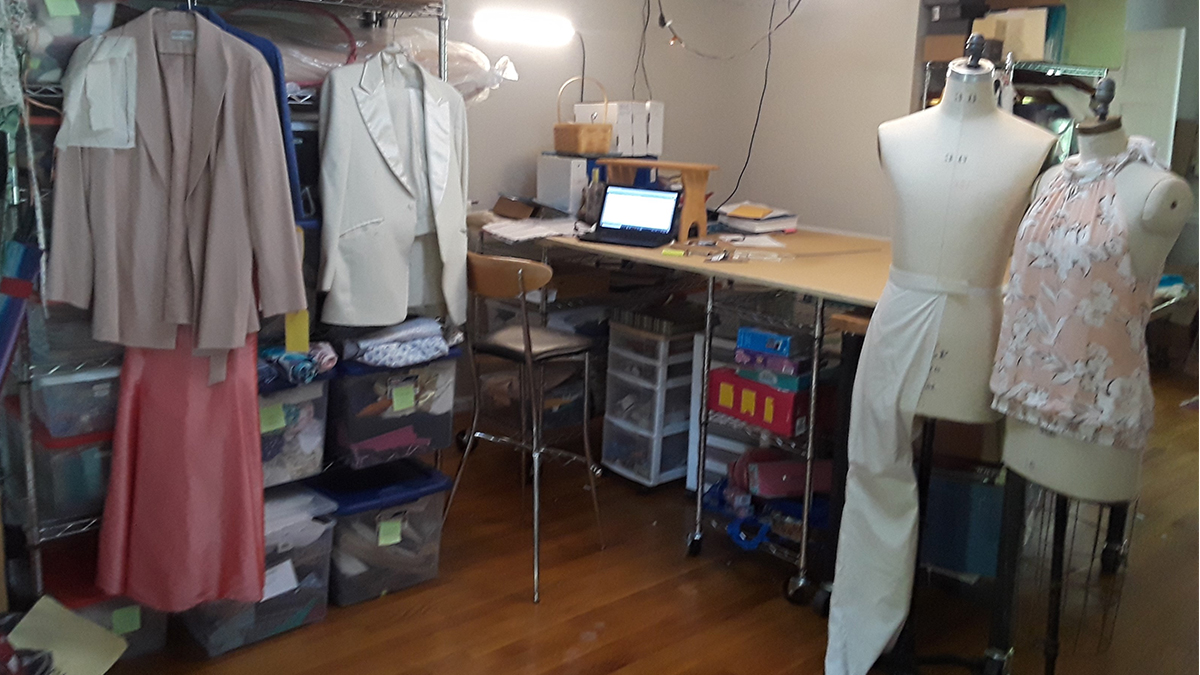Morris and Bayang found a way for costume production students to finish their projects remotely by mailing them sewing supplies and equipment.

Triffin Morris
Head of the Master of Fine Arts in costume production program and costume director of PlayMakers Repertory Company
2 years at Carolina
Jennifer Bayang
Teaching assistant professor and assistant costume director of PlayMakers Repertory Company
6 years at Carolina
What are students in costume production courses learning?

Triffin: In the costume production program we teach our students how to make patterns the costumes professionally. The designer chooses the fabric and draws a picture of what it’s supposed to look like. We take the design, the actors’ measurements and the needs of the show into consideration and create a garment. The program also covers costume crafts, which is millinery work, making hats, masks and armor as well. We might be finding new ways to reach our students, but what we do is old school. We deal with paper, fabric, thread and dress forms, not computers.
How are you helping your students finish the semester remotely?

Jennifer: I manage everything that goes on in the shop where we make costumes and supplies for PlayMakers Repertory theatre, and the students work as staff in the afternoon and practice what they’re learning by making costumes for the productions. Once we realized that we couldn’t continue with the mainstage shows, my job was then to use what we had in the shop to make sure the students had everything they needed to continue with their classwork.
Triffin: The classes we teach involve advanced sewing techniques, so my students needed sewing supplies like fabric, sewing machines, paper and dress forms to finish specific projects that they’re working on. Jennifer and I asked the students what supplies they didn’t have on hand, and sent packages out to students with whatever supplies they needed – the farthest we’ve had to mail anything so far has been to a student in Ireland.
What is the biggest challenge you’ve faced when teaching remotely?
Triffin: The scale of what I teach is human-sized, so the hardest aspect of teaching remotely has been experimenting with how to shrink down what I need to show my students onto a scale that’s as small as a piece of paper.
Jennifer: The shop is usually a pretty busy place, because when students aren’t working on assignments they’re producing work for the main stage, so when all students left it was unusually quiet. The challenge is staying connected to the students and keeping them up to date with what’s happening. This is an especially collaborative field, so to not have peers around to discuss ideas with and build up each other’s energy is hard.
How have you transitioned to working from home?
Triffin: I just came into this position two years ago after working in New York making costumes for Broadway shows, so I have a full-scale shop in my house. The last element I’m going to add to teach is a camera installed above my work table so my students can watch me adjust patterns.
Jennifer: I have a much smaller shop, but I have a small area where I’m sewing fabric masks for UNC hospitals and other health care workers in the area who are working with COVID-19 patients.
What are the fabric masks you’re making used for, and are they difficult to sew?
Jennifer: There are two different kinds of masks: shaped and pleated. The pleated masks are the simplest to make, and they just slip over an N95 mask, which prolongs the use of that mask because they can remove the fabric and wash it. The shaped masks have a pocket that someone can fit an N95 mask or other filtration into, also with the purpose of prolonging the use of that mask. Even people with very basic sewing skills can sew the pleated mask easily. There are instructions online from stores like Joann Fabrics on how to sew masks, and UNC Health has multiple drop-off locations to take the finished product.
Editor’s note: With the help of UNC’s IT staff, Morris got a camera installed over her cutting table. She hung a shelf from the ceiling over her cutting table and is using one of UNC’s document cameras. The camera is connected to her laptop so when she shares her screen, students can see her demonstrations on the table.
Carolina People is a regular feature that asks one of your fascinating colleagues questions about the work they do for the University. Do you know someone with an interesting or unique job at Carolina? Please email your suggestions to thewell@unc.edu and put Carolina People in the subject line.
By Madeline Pace, The Well
